 Often totally engrossed with preparing their classic car for bodywork repairs and painting, restorers might be inclined to forget about the vehicle's underside.
Often totally engrossed with preparing their classic car for bodywork repairs and painting, restorers might be inclined to forget about the vehicle's underside.
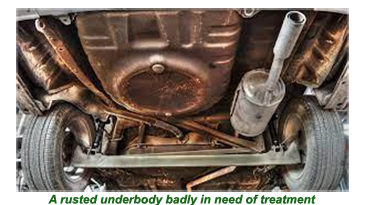 The underside of any vehicle is least exposed to the eye. Only when it is up on a ramp can the restorer get a clear view of the underbody that they may just have purchased- and it is often not a pretty sight.
The underside of any vehicle is least exposed to the eye. Only when it is up on a ramp can the restorer get a clear view of the underbody that they may just have purchased- and it is often not a pretty sight.
Wide open to all the elements, the vehicle's underside is a massive potential weak spot indirectly exposed to all of the elements - the rain, snow, slush and gravel that bounces up from the road, as well as the oils and chemicals that leak downwards from the engine, cooling and fuel systems.
 The restorer must ensure that every effort has been made to protect it from above and below when it begins its new lease of life with a comprehensive protective undercoat.
The restorer must ensure that every effort has been made to protect it from above and below when it begins its new lease of life with a comprehensive protective undercoat.
On the upside, there is no real reason to be gentle with the underside of the vehicle. All that is required is that the underside ( including the wheel arches) be coated with a dense material to prevent oxygen intrusion and be totally waterproof.
A few options are available that are inexpensive, easy to apply, but carrying considerable doubts whether they will remain totally waterproof in the long term.
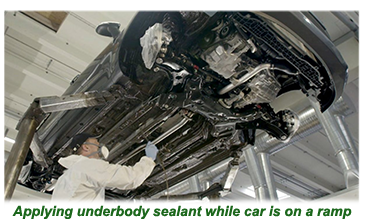 Bitumen is, without doubt, the entry-level undersealer, which, if applied in thick enough layers, can be expected to provide reasonable protection for a few years.
Bitumen is, without doubt, the entry-level undersealer, which, if applied in thick enough layers, can be expected to provide reasonable protection for a few years.
After a while, Bitumen can become brittle and eventually crack, allowing the inevitable meeting between water and metal again leading to corrosion.
If there ever was a case for reminding that well-known expression "spoiling a ship for ha'peth of tar", applying Bitumen to the underside of a vehicle could be described as a classic example- in other words, why spend thousands restoring a classic car and risking the chance of ruining it to save a few hundred.
![]()
If any sealing has to be done, epoxy primers have always proved effective for sealing bare metal, preventing moisture from creeping in, leading to corrosion.
Epoxy primers are non-porous and soak up moisture, a fault found with most primer-sealers, filled with binding elements that ensure that oxygen cannot penetrate it, thus triggering corrosion.
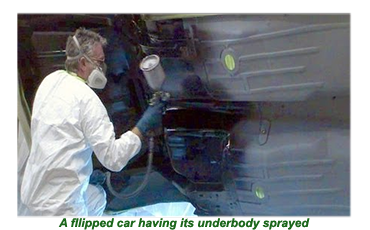 Epoxy primer is available in two formats, One-part or Two-part.
Epoxy primer is available in two formats, One-part or Two-part.
One-part epoxy primer:
One-part epoxy primer is comprised of a single sealer designed to enhance a smooth finish paint job.
Because of its ability to create a non-porous finish, epoxy primer is usually the first base coat applied to bare steel. It can be readily applied to black iron pipes, fibreglass, and plastic.
One-part epoxy primer lends itself especially well to coating bare metal making it the best option on a no-frills paint job.
Two-part epoxy primer
The vital extra ingredient found in a two-part epoxy primer is zinc phosphate, which works very well in tandem with the sealer by cross-linking chemically.
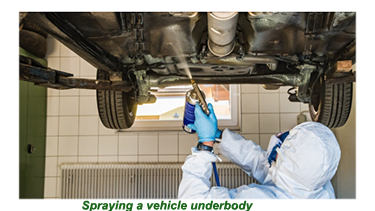 What makes zinc phosphate a vital ingredient is the material's ability to prevent corrosion spread over the long term, making Two-part epoxy primer possibly the most prudent investment for a restorer who wants to ensure that the underside of their vehicle will receive ultimate protection over the long term.
What makes zinc phosphate a vital ingredient is the material's ability to prevent corrosion spread over the long term, making Two-part epoxy primer possibly the most prudent investment for a restorer who wants to ensure that the underside of their vehicle will receive ultimate protection over the long term.
Once it has been settled which underbody sealant will do the job, the first stage of sealing the underbody is to hose the underside thoroughly using hot water mixed with a small quantity of detergent.
The next stage is to mask the entire exhaust system and hydraulic pipes, and the moving parts of the braking and suspension systems, after which the sealant can begin to be applied.
![]()
The ideal situation is to apply the underbody when the vehicle is up on a ramp using a spray gun.
Those who do not have a spray gun should use a two inch paintbrush to do the job.
This way will take longer but should be a lot cleaner.
Anyone who does not have access to a hydraulic ramp should investigate the possibility of acquiring a simple flipping frame that will allow easy access to the vehicle underside.
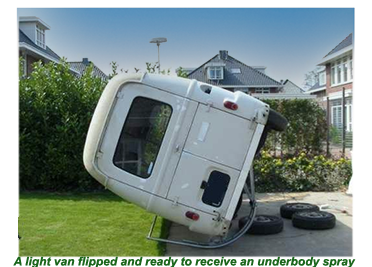 The work area where the underbody coating will be applied should also be covered, preferably with plastic sheeting- if not, an old dust sheet or similar should be used to catch any drips.
The work area where the underbody coating will be applied should also be covered, preferably with plastic sheeting- if not, an old dust sheet or similar should be used to catch any drips.
It's a must to wear old clothes and head coverings, as well as goggles and rubber gloves when applying an underbody seal.
The paintbrush should be done away with when the job is completed as it will be impossible to clean.
 When applying the sealant, it is recommended to work in sections, making constant checks of each section to ensure that each of the areas to be painted have been entirely covered before moving on to the next section.
When applying the sealant, it is recommended to work in sections, making constant checks of each section to ensure that each of the areas to be painted have been entirely covered before moving on to the next section.
 Special attention must be paid when undersealing the vehicle's wings, especially the usually inaccessible top front and top rear corners, to ensure that these areas are completely sealed.
Special attention must be paid when undersealing the vehicle's wings, especially the usually inaccessible top front and top rear corners, to ensure that these areas are completely sealed.
Once the sealing is complete, all that remains is to remove the masking tape, and another significant step forward csn be marked.
pw3

